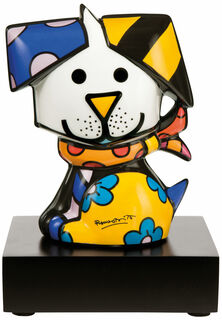Porcelain sculpture "Coco the Dog"
Porcelain sculpture "Coco the Dog"
Quick info
porcelain | wood | total size 13.5 x 9.5 x 8.5 cm (h/w/d)
Detailed description
Porcelain sculpture "Coco the Dog"
Happiness, joy, cheerfulness and all-around jolliness - that is what the original and enriching works of art by the Brazilian self-taught artist Romero Britto spread. He designs these works influenced by the stylistic elements of pop art and comics in a typical, well-balanced mix of patterns and colours. This gives the expressive works a high recognition value.
This dotted, flowered, and striped porcelain dog is a fashion-conscious and cheerful companion for all situations in life. Size incl. wooden base 13.5 x 9.5 x 8.5 cm (h/w/d).
Customer reviews
Skulptur ist so, wie erwartet. Komplikationsloses bestellen und schnelle Lieferung.
Super Teil.
Coco ist einfach niedlich …

About Romero Britto
Romero Britto: Always Sunshine in the Heart
Through his multi-coloured cheerful paintings and sculptures, the Brazilian artist, born in 1963, fills the lives of his many collectors with joy and hope. Celebrities like Steffi Graf and André Agassi, as well as many actors and the Kennedy clan or Barack Obama, are just a few of many of Romero Britto's customers. This is not surprising, since the works of the Pop Art artist are directly related to the pioneers of this style, Roy Lichtenstein and Andy Warhol.
Pop Art developed at the beginning of the 1960s as a counterpoint to the ideas of Abstract Expressionism of the post-war era, using the stylistic elements of everyday life and the artistic form concept of comics. The ordinary is elevated to the status of a work of art.
With black-framed colour surfaces, Romero Britto stylises the pictorial theme into precise figures that live through their bright colours without any illusion of depth or plasticity, appealing directly to the viewer's feelings. He designs the coloured areas with geometric patterns such as lines, circles, and hatchings. In this way, they retain the characteristics of a comic strip and tell imaginative stories to every viewer.
Like no other artist, Britto cooperates with influential brands such as Audi, BMW, Absolut-Vodka, Apple, Pepsi, and Disney. The life-affirming message of his playful images helps the artist in his work with many foundations, which he supports with the "Britto Foundation", founded in 2007. Today, Britto's works are traded for several tens of thousands of euros.
Ceramic product made of kaolin, quartz and feldspar.
Porcelain is formed by turning or pressing and figurative objects are cast. Complex objects have to be cast in separated steps and sections and then "assembled". After the moulding, the pieces are dried and "annealed" at about 900 °C. Next, the glaze will be applied and fired at temperatures between 1,240 °C and 1,445 °C. In renowned manufactures, the porcelain is painted by hand whereby each colour has to be fired individually and in compliance with narrow temperature tolerances.
Porcelain was invented in China and became widespread in Europe from the 16th century onwards. The first European porcelain factory was founded in Meissen, Germany in 1710.
Other famous European porcelain factories include Fürstenberg, Höchst, Schwarzburger Werkstätten, Lladró, Nymphenburg, KPM, Augarten, Sèvres, Limoges, Royal Copenhagen, Worcester. Individual factories label their products with their personal porcelain stamps so that for the collecter it is easy to identify their origin.
A plastic work of sculptural art made of wood, stone, ivory, bronze or other metals.
While sculptures from wood, ivory or stone are made directly from the block of material, in bronze casting a working model is prepared at first. Usually, it is made of clay or other easily mouldable materials.
The prime time of sculpture after the Greek and Roman antiquity was the Renaissance. Impressionism gave a new impulse to the sculptural arts. Contemporary artists such as Jorg Immendorf, Andora, and Markus Lupertz also enriched sculptures with outstanding works.


